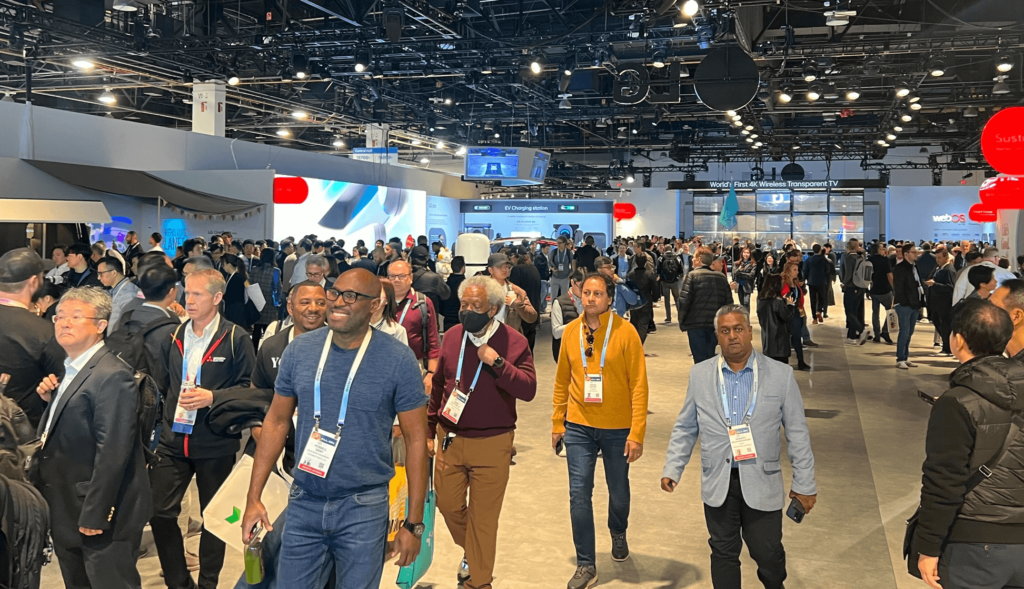Takeaways from CES 2024 for video service providers
The annual Consumer Electronics Show (CES 2024) always grabs global headlines with eye-catching new gadgets and ever-expanding TV screen sizes. This year was no different, with acres of coverage for LG and Samsung’s new transparent TV screens, the latest virtual reality concepts, and robots that will make you anything from a cocktail to a stir-fry.
But, like the bright lights and razzmatazz of the host city, Las Vegas, the show-floor glitz of CES 2024 is largely a temporary distraction for the video entertainment industry. Behind the scenes, there are serious conversations about the future of streaming. So what were video service providers really talking about at CES 2024?
Magine Pro’s Sales Director, Neil Fender, at CES 2024.
Interest in AI is becoming more targeted
Just as we saw at IBC and NAB in 2023, Artificial Intelligence (AI) continued to be a major buzzword. Our CEO, Matthew Wilkinson, touched on this important topic in his recent blog on Large Language Models and Generative AI. But the partners and customers (both current and future) that I spoke to in Las Vegas are increasingly focused on the practicalities of deploying this constantly evolving technology. They’ve gone beyond wondering how AI might revolutionise the industry in the future, to looking at very specific use cases that will advance their short-term goals, not just their longer-term planning.
With consumers around the world becoming increasingly cost-conscious, churn is a massive area of focus for every streaming service, no matter what combination of business models they’re using. The video services I spoke to are looking for a strong and immediate return on investment for any foray into AI. In particular, they want it to keep consumers engaged so they’re less likely to look elsewhere for content. The benefits of offering personalized content recommendations are the most often-cited strategy for growing engagement, so it was a pleasure to be able to talk about the AI-powered recommendation capabilities in Magine Pro’s end-to-end OTT streaming platform .
I was also happy to talk through some of the tactics that have paid dividends for our existing customers when tackling churn. For example, the “dunning” functionality in our advanced billing engine enables them to systematically communicate with consumers whose payment methods have expired or failed. This proactive strategy prevents passive involuntary churn, minimising customer loss and ensuring a positive user experience. Another proactive approach is to automate “win-back” strategies. This means offering targeted discounts to certain users who have recently churned, or shown signs of being a flight-risk, to help keep them on-board.
We’ll have more about these tactics in our upcoming e-guide on advanced OTT monetization strategies. Register now to be among the first to get the guide, which will also explain some of the reasons we champion hybrid monetization models.
No moving out of the FAST-lane
I don’t think anyone was surprised to find that FAST – another of the biggest streaming trends of 2023 – was still a hot topic at CES. The low barriers to entry mean that FAST channels continue to be the most popular route into the streaming market for content owners, particularly in the US market.
The FAST trend I heard most about at CES, however, was those who’ve dipped a toe into streaming with FAST channels via aggregation platforms like Roku, Amazon, LG, and Samsung and now want their own suite of streaming apps to build a direct relationship with consumers. We had some excellent conversations at CES with technology partners and customers about how we can help them make that ambition a reality with the Magine Pro OTT platform because it’s quick and easy to launch, but also customizable so it can grow with their business.


Want to know more?
If you weren’t able to make it to CES 2024, you can book a meeting with our team to talk about how AI recommendations could improve your engagement, or how Magine Pro can elevate your content distribution and monetization strategies.

